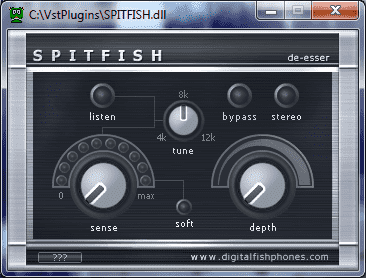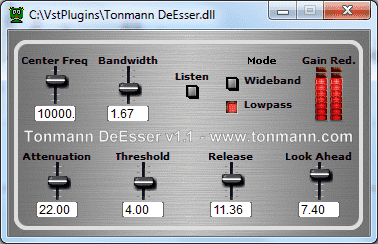- Free Deesser Plug In
- Deesser Stereo Vst
- Free Deesser Fl
- Desser Vst Free
- Free 64 Bit Deesser Vst
- Desser Vst Free
De-esser, free, vst Update: I just finished the work on version 1.2, which I now offer as a free download below. This version brings an all new “decent” GUI, kindly created by DeLaMancha ( www.delamancha.co.uk ), the de-normal and multicore-problems are (hopefully) fixed.
- Free VST downloads: Chopper (Pattern controlled gate by Oli Larkin) - Tonmann DeEsser (DeEsser by Tonmann) - GT Sidechain Gate (Sidechain gate by Glitchtek) - Efektor Silencer (Dual / mono noise gate by Kuassa) - A1TriggerGate (Sequenced gate by A1AUDIO.de) - Lisp (De-esser by Sleepy-Time DSP) - LSGate (Rhythmic gate by LittleStudios) - ReaGate.
- CPU: Intel Core i3 / i5 / i7 / Xeon / AMD Quad-Core. Memory: 4 GB RAM, 4 GB free disk space on the system drive. Operating System: Windows 7 with SP1 64 bit, Windows 8.1 64 bit, Windows 10 64 bit. Screen Resolution: Minimum - 1024x768, Recommended - 1280x1024 / 1600x1024.
Knowing what a de esser is and how to use it can make your production shine.
You’ll hear these types of amateur-ish sonding music a lot. No matter how good your mix sounds, the entire mix can be spoilt with those annoying ‘s’ sibilance, usually in vocal tracks.
Sibilance is the hissing sound you get when pronouncing letters with ‘s’ in them. Examples of such words are ‘spaces’, ‘special’, ‘sun’, etc.. I like to think that sibilance is the result of sudden gush of airflow of the mouth when saying/singing words with ‘ess’ or ‘shhs’ in them.
Here’s a video by Sami Rudnick – she explains what sibilance is and how to solve them when you’re singing or talking. Give the video a watch and try the techniques, if you’re a singer.

Free Deesser Plug In
Sibilance that you find in recording can be because of few reasons:
- natural sibilance in our pronunciation – thus no way to avoid this
- recording vocals in an untreated studio or room
- compressing the wrong frequencies on your vocal tracks
- singer who has an exceptionally sibilant type of voice.
However even with great vocal techniques, you cannot avoid having sibilance in your vocal tracks. And something has to be done with it. Leaving it on your vocal tracks is a recipe to craft an amateur sounding song.
So let’s get rid of it.
It doesn’t matter if you are using a de esser in adobe audition or using one in Logic Pro, the methods to use a de-esser plugin is the same. The de-esser plugin is a very simple effect that can be mastered every easily.
Deesser Stereo Vst
A de-esser plugin is basically a compressor that compresses your audio signal when it detects a sibilance in your track. It achieves this by only reducing the frequency of which the sibilance is.
You normally have 2-4 parameters to toy about on a de-esser plugin. In the image above, you’ll find a ‘reduction’ knob on a de esser. The reduction knob is usually measured in decibels, where you dial in the amount of reduction you want the de esser to reduce whenever it hears a sibilance problem in your track. We then have the ‘threshold’ parameter. Keeping in mind that a de esser is essentially a compressor that compresses the frequencies in which sibilance is, the threshold is the level where the de esser considers the sibilance too prominent. There is then the ‘release’ knob that works the same as a compressor, determining how soon the de esser plugin ‘lets go’ off the signal after compressing it.
In some de esser vst plugins, you’ll find a frequency knob as well. That can be really helpful in spotting the frequencies that you’d like to reduce.
Spitfish De EsserI used to be on Logic Studio. If I remember, Logic X’s de esser plugin is a little confusing to use. If you need a great third party de esser vst plugin, try SpitFish, a totally free de esser VST plugin.
Free Deesser Fl
You’ll find heated discussions on whether to de ess before or after compression. In fact, should you de ess first before inserting any more effect plugins? Go to any music forums on music production and you’ll find tons of threads discussing this.
I find de essing a vocal track before applying any sort of effects to work better. However, there is no rule that you must follow for this. When mixing, I normally have the mindset to clean and fix all sound issues in the track before applying any cosmetics on the track.
However when I do find the track having need another de esser after going through all the effects, I sometimes insert another de esser plugin at the end of the insert chain or in a mix bus with a very subtle reduction. If you like a plugin that does this very well while allowing you to change the signal chain flow, take iZotope Nectar for a spin. One of the easiest vocal plugin to use to get very nice results while being not that expensive.
This is my favorite way of de essing. I also find de essing manually gives the most satisfying results.
So if you’re not a lazy twag, don’t have an in-built de esser plugin in your DAW or don’t have cash to buy a plugin, then learn how to do it manually.
First, identify how problem sibilance look like:
The waveform would look denser when it has ‘sshes’ in them. Zoom in your audio tracks and you’ll immediately notice the different of those the problem areas.
Second, open up your volume automation. I’m doing this in Cubase but automations should be available in most DAWs. Create points at the problematic areas with sibilance and then pull down the volume automation in that section by about -4dB to -6dB depending on how severe the sibilance is.
Desser Vst Free
Reduce by about -4dB | De Essing How ToTrying to de-ess manually definitely takes more time but I promise you that it’ll give you better results. You may be tempted to simply just use a de esser plugin and slap it across your tracks but you’ll end up de essing parts in your tracks that you don’t want any de essing.
Free 64 Bit Deesser Vst
So hopefully you can remove the S sounds of your vocal tracks through this tutorial and end up with a cleaner and professional sounding track. Keep in mind that you’re going to always record ‘S’s when you record, but rest assure that you can remove them pretty easily during the mixing stage.
Desser Vst Free
Oh! And make sure to turn down the volume of your monitors when you’re de essing. The ‘S’s in your track can be very ear piercing (that’s why we remove it anyway} so turn down the volume knob if you don’t want to end your career early.

Comments are closed.